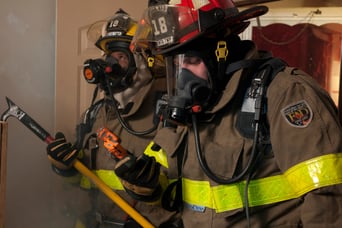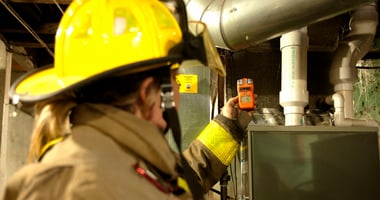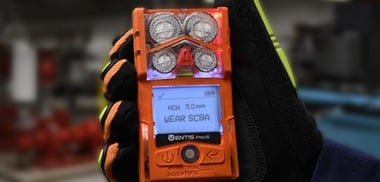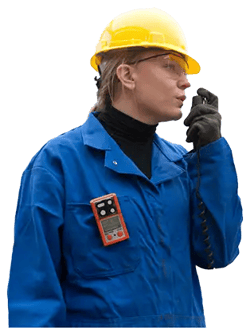As a firefighter or member of an emergency response crew, you face gas-related risks at every stage of the job. Toxic fumes can linger long after a fire is extinguished, and without a reliable multi-gas detector, you can’t be certain that the air in the cold zone is safe. That’s why portable multi-gas detectors have become an essential part of turnout gear for many teams, helping you stay protected on every call.
Here are five key reasons to make multi-gas detectors a priority for your fire department.
1. Multi-Gas Detectors are Ideal for Every Scenario
Fire departments are increasingly responding to calls where invisible, deadly gases may be lurking, so having the right gas detection equipment in place is more important than ever.
Fire departments respond to plenty of home calls concerning carbon monoxide (CO) alarms. Multi-gas detectors can not only detect the presence of CO, but they can also help you determine the source of the CO leak. In addition to detecting CO, you can use a multi-gas detector for home calls concerning natural gas leaks or other suspicious odors.
Although CO calls are common for firefighters, there are other lesser-known gas hazards you need to monitor. Fire smoke is a complex mix of toxins, and hydrogen cyanide (HCN) has emerged as one of the most common and dangerous. Historically, HCN was not a concern after a typical house fire. But as synthetic materials replace natural materials in the construction industry, HCN has become more prevalent. When heated, these materials emit HCN at levels unimaginable to firefighters from decades past. Multi-gas monitors alert you when HCN is present, in addition to other common gas hazards, creating additional awareness around the need for respiratory protection.
2. They Enhance Team Safety
Many fire departments may only have one multi-gas detector per rig – or even just one for the entire department. While one monitor per department or per rig is exponentially better than no monitors at all, there are several benefits to each firefighter carrying a multi-gas detector.
Multi-gas monitors, like the Ventis® Pro5, can share alarms and gas readings between monitors. These monitors can also provide real-time location and alarm data to a central controller who can monitor the scene and dispatch additional help when necessary. These connectivity features are proven to improve your crew’s safety and awareness of their surroundings.
What does this look like for your firefighters? If one of your crew goes into a structure and her monitor detects a surge in HCN or any other gas, the rest of your crew will see the alarms on their own monitors, showing them who is in trouble and what the atmospheric conditions are—so they know exactly how to initiate the rescue.
3. Durability and Reliability
Multi-gas detectors used by fire departments must be built to withstand extreme conditions. Devices like the Ventis® Pro5, with its IP68 rating, offer protection against total dust ingress and long-term immersion in water, ensuring reliability in the toughest environments. Tested in extreme conditions, the Ventis Pro5 is designed to meet the demands of emergency response work.
Fire departments should prioritize gas monitors that can keep up with their crew, offering durability and long-term reliability to ensure consistent safety on the job.
4. Maintenance is Simple
It's easy to look at multi-gas detectors and see them as more equipment to maintain. However, the truth is that modern gas monitors are easy to care for with the right tools. There are several ways you can simplify or even automate maintenance so your crew gets the gas detection it needs without wasting valuable time.
To simplify routine maintenance, you can rely on the DSX Docking Station. The docking station automatically bump tests and calibrates monitors according to your schedule, so you don't have to spend time doing it manually. It's as simple as placing the multi-gas monitors on the DSX Docking Station when they're not in use. The gas monitors will automatically be charged, bump tested daily, and calibrated to your local safety requirements. Records of each of these activities are stored digitally, so you can access records and certificates in an instant.
If the docking station ever identifies that a monitor’s performance is declining, you can automatically have a new monitor shipped to you through iNet® Exchange. With this service, you can completely eliminate warranty claims and time spent managing repairs.
With these maintenance options in place, you never need to worry about whether your gas monitors are ready to use.
5. Budget-Friendly
Multi-gas monitors are relatively inexpensive for the amount of protection they provide. While they do carry an upfront cost, they ensure the safety of each firefighter in your department for several years. In fact, by preventing just one on-the-job injury, a monitor more than pays for itself, making it easy to justify the budget.
For larger fire departments with more than ten gas monitors, a gas detector exchange program provides a cost-effective option for keeping the fleet up and running. By eliminating labor costs and hassles, this type of service not only eliminates unexpected expenses, but also gives your crew more time to focus on keeping your community safe.
You know that when your crew is responding to a call, the right tools make all the difference. If multi-gas detectors aren’t part of your crew’s turnout gear, it’s time to step up your safety game. We can help you find the right gas detection program to make it easy to get the protection you need. You can learn more about gas detectors and fire safety or contact us for help.



